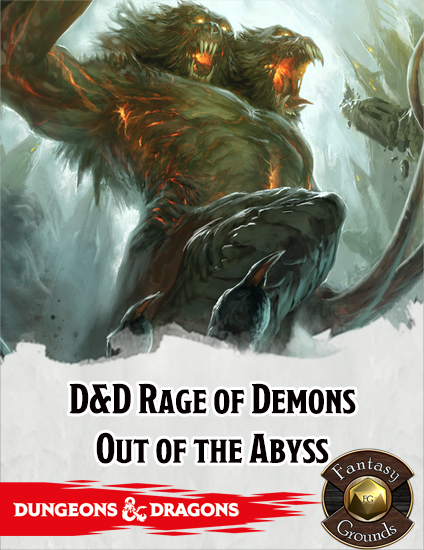Abyssal Accuracy

In Out of the Abyss, “madness” is used in a frustratingly stupid way.
Fans of the Forgotten realms campaign setting have had the chance to see some advances in the world’s metaplot this year with the release of some of the new D&D books. In particular, I’m a bit more than halfway through reading Out of the Abyss, a monster of a sourcebook which puts players in the position of trying to thwart a demonic incursion into the Underdark. I can’t honestly say that it’s the finest adventure I’ve ever read, but it’s pretty well written and well structured, and I can see the book being used to good effect by a skilled storyteller. Disappointingly, I found myself with one major complaint about the book, and it isn’t a new one: “madness” is used in a frustratingly stupid way.
The problem with Out of the Abyss is that people seem to be “going mad” left and right. On the one hand, this is logical. The story is all about the most terrible of demon lords manifesting on the prime material and the corrupting influence this has on all life around them, and countless writers have described how contact with ancient, ineffable evil shatters the sanity of poor mortals in Lovecraftian fashion. There’s just one problem with that: it’s utter nonsense. Granted, I’ve never evaluated a patient whose mental illness started with exposure to demons – that I know of, at least – so perhaps my real-world experience has no bearing on the effect of exposure to the lords of the Abyss, but the fact is that mental disorder in our world doesn’t work that way, spontaneously appearing every time someone is faced with a traumatic situation.
In Out of the Abyss, there are a whole bunch of ways to “go mad.” In brief, different regions of the Underdark fall under the sway of different demon lords, and creatures within these regions slowly develop strange behaviour. Most commonly, creatures seem to become delusional or paranoid. A small number of creatures become convinced that they belong to another species or have been chosen by one deity or another. In the case of player characters, whose madnesses aren’t pre-determined to drive the story, it’s a bit more random, and the book pretty much says to open chapter 8 of the 5E DMG and roll on the various madness tables. According to these tables, characters and NPCs might be afflicted with “short term” madness lasting 1d10 minutes (retreating into their own mind and becoming paralyzed, uncontrollably laughing or screaming, fleeing in terror, fainting, or hallucinating), “long term” madness lasting 1d10 x10 hours (repetitive compulsions, hallucinations, paranoia, delusions, obsessions, blindness or deafness, or amnesia), or “indefinite” madness which lasts until cured (alcoholism, kleptomania, dissociation, narcissism or psychopathy). Many of the conditions listed in the DMG are actual common symptoms of mental disorders, but a significant number are really things that don’t exist outside of TV and movies. Very few of them are conditions which are typically caused by terror or horror in real life. The majority of them can make for fantastic storytelling tools or roleplaying opportunities, but they’re totally unrelated to anything even remotely realistic.
None of this is meant to minimize what trauma can actually do to people. Most mental disorders are more likely to occur in someone who has lived through traumatic life events. Post-traumatic stress disorder is obviously one condition that can be caused by trauma, but all forms of depression and anxiety can be brought on by trauma. Even disorders which modern medicine thinks of as being in-born, such as borderline and antisocial personality disorders or schizophrenia and bipolar disorders, may be more likely to develop in someone following stress. That being said, unlike in Out of the Abyss, you wouldn’t see one of your neighbours fail a single saving throw and, as a result, suddenly become an alcoholic or a serial killer, or suddenly develop obsessive compulsive disorder or mixed auditory and visual hallucinations. That simply isn’t how it works.
What this really shows is that the people who write these campaigns are in touch with one major thing we’re afraid of: going mad. Rightly or wrongly, many people fear “going crazy” more than they do breaking a limb, getting pneumonia, or even developing a cancer. I’m not even going to say that this is wholly unreasonable, since in some respects we can actually treat some cancers more effectively than we can some mental disorders. Madness works well in our games because it’s something we’re afraid of… in much the same way that many people are unnecessarily afraid of werewolves. Either way, the fact is that the way madness is portrayed in Out of the Abyss makes for great storytelling but painfully poor educating, and one unfortunate side effect is that kids (and plenty of adults) who play through this storyline are going to have their mental image of mental disorder shaped by it, increasing stigma towards and distrust of people who have treatable illnesses.
So there’s your political commentary for the day. You’re welcome to ignore it and get back to your game if you like. There’s absolutely nothing wrong with saying you don’t want your games to be burdened by excess realism, but we should all at least have some idea of which realities we’re choosing to ignore.
More than four years ago, Dr. Eris Lis, M.D., began writing a series of brilliant and informative posts on RPGs through the eyes of a medical professional, and this is the one that appeared here on March 27, 2016. Lis is a physician, gamer, and author of the Skirmisher Publishing LLC OGL sourcebook Insults & Injuries, which is also available for the Pathfinder RPG system.






